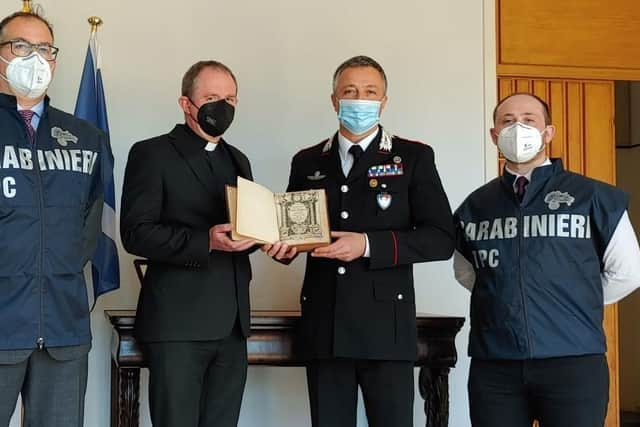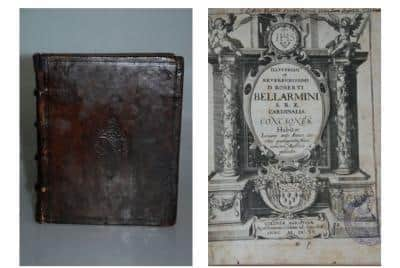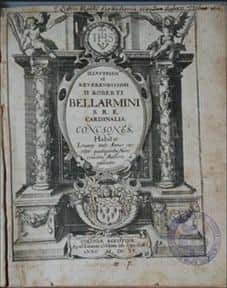Scotland's 'heritage detective' hunts down priceless works and protects ancient monuments
Cardinal Bellerine’s 1605 book of sermons had vanished from the archives of the College of St Peter in Glasgow and finally resurfaced on a Dutch auction site in September 2020.
It was gifted to the church in Glasgow in the early 1900s but it is unknown when it was removed from the collection.
Advertisement
Hide AdAdvertisement
Hide AdThe book was sold to a buyer in Italy but as it is against Canon law to alienate property of the church it was seized by officers from the Carabinieri after discussions with Police Scotland.
A graduate in ancient history, Det Sgt Telford sits on the heritage crime group and was tasked with the job of tracing the origins of the book after receiving the tip from Chief Warrant Officer Luigi Portace in Italy.
He told the justice and social affairs magazine, 1919: “Italy is one of these places where you can just stick a spade in the ground and find something. So, they proactively monitor online sales. Luigi contacted me to let me know he’d seen this book for sale online in Holland, and then he saw the stamp on it, did some research, and found out it was the map of the College of St Peter and this raised suspicions for him."
Telford’s first job was to try to ascertain whether the book was stolen, which is still unanswered.
He said: “The College of St Peter was a priest training college, and the collection this book had come from was a reference library; the books shouldn’t have been getting taken out.


“The collection was a couple of hundred years old, and it moved several times to different locations, different parts of Glasgow. There had been a fire at one point, so it’s clearly been in the collection and just sort of not been recorded at some point. And then at some point it had been removed, and we couldn’t really confirm it.
“We didn’t have an idea about the time at all, so we thought, let’s try and narrow it down, let’s see if we can work out when it came into the collection.”
A handwritten signature on the inside cover of the book read W Gordon, a priest who died in 1880.
Advertisement
Hide AdAdvertisement
Hide AdHowever, when the catalogue was recorded in 1981, it was no longer there.


“We couldn’t say somebody sneaked in and shoved it up their jumper for the purpose of taking it and selling it,” Telford admitted.
He went to the Dutch police and was told the book had been sold and was now in Italy.
Telford said: “Luigi and I prepared a report for the Italian prosecutors who authorised the seizure of the book.”
The book was moved to the Scots College in Rome in April before being safely returned to the Archdiocese of Glasgow last month.


Telford continued: “The teachings in the book were quite significantly tied into the Reformation in Scotland, so it actually had a real significant Scottish history, not just the Catholic Church. It was a bit Dan Brown trying to find out about all the priest history.”
He says he “fell into” heritage crime because he studied ancient history at university and completed a postgraduate in antiquities tracking and art crime at Glasgow University, leading to a seat on the heritage crime group, which is made up of partners including Historic Environment Scotland and the Treasure Trove Unit.
Heritage crime is a big issue in Scotland and one steadily gaining recognition as such.
Advertisement
Hide AdAdvertisement
Hide AdLast month two people were sentenced to a Community Payback Order requiring them to carry out 80 hours unpaid work and supervision for six months following illegal metal detecting and excavation which caused irreversible damage to Dunadd Fort in Kilmartin Glen.
“The main problem we have in Scotland is damage to scheduled monuments,” explains Telford. “There’s 8,000 scheduled monuments in Scotland, and they’re all managed by Historic Environment Scotland.
“When folk think of scheduled monuments, they’re maybe thinking of a big stone monolith or whatever, and yes, it can be that, but it can also be, for example, the sunken World War One German fleet at Scapa Flow.
“The entirety of Holyrood Park in Edinburgh is a scheduled monument. The Antonine Wall which cuts right across the middle of the country, that entire thing is a scheduled monument. They really can take any form.
“The problem is, for example, metal detecting on scheduled monuments. People might be going metal detecting, digging stuff up, finding it, and that’s a problem but we don’t necessarily know the extent of it because it doesn’t get reported. It’s maybe off in a rural area, or people might see a hole and not realise the significance of it.
“You’ve potentially got really significant cultural material there that has been removed. And even if it was found for sale online and we recovered it at a later date, quite often that’s almost irrelevant because its material value is often negligible, where the value is its historical context. So, once it’s out the ground, it can be a real problem.”
“It’s an offence to not only metal detect on a scheduled monument and dig something up, but actually just the act of having a metal detector and using it, even if you’re not digging anything up, that is an offence.